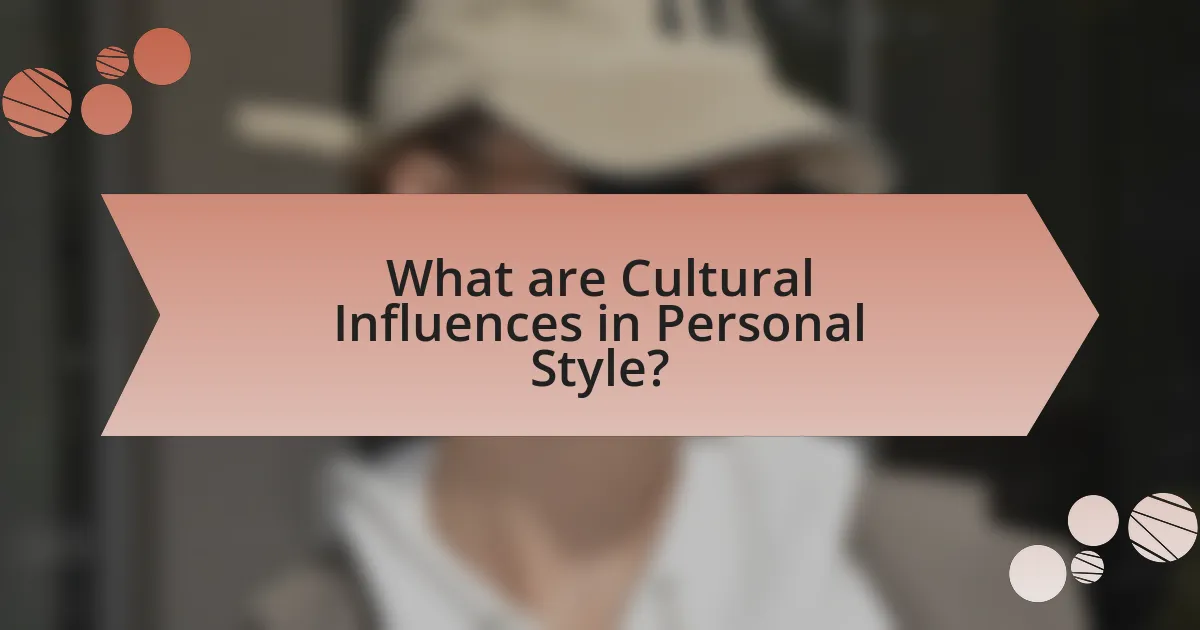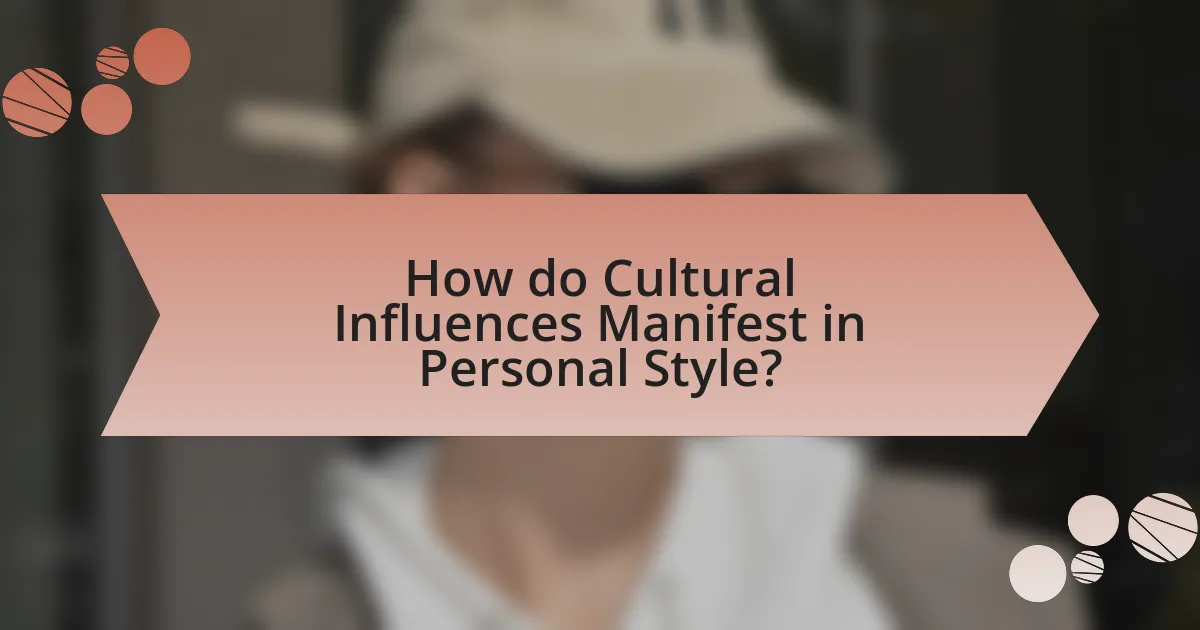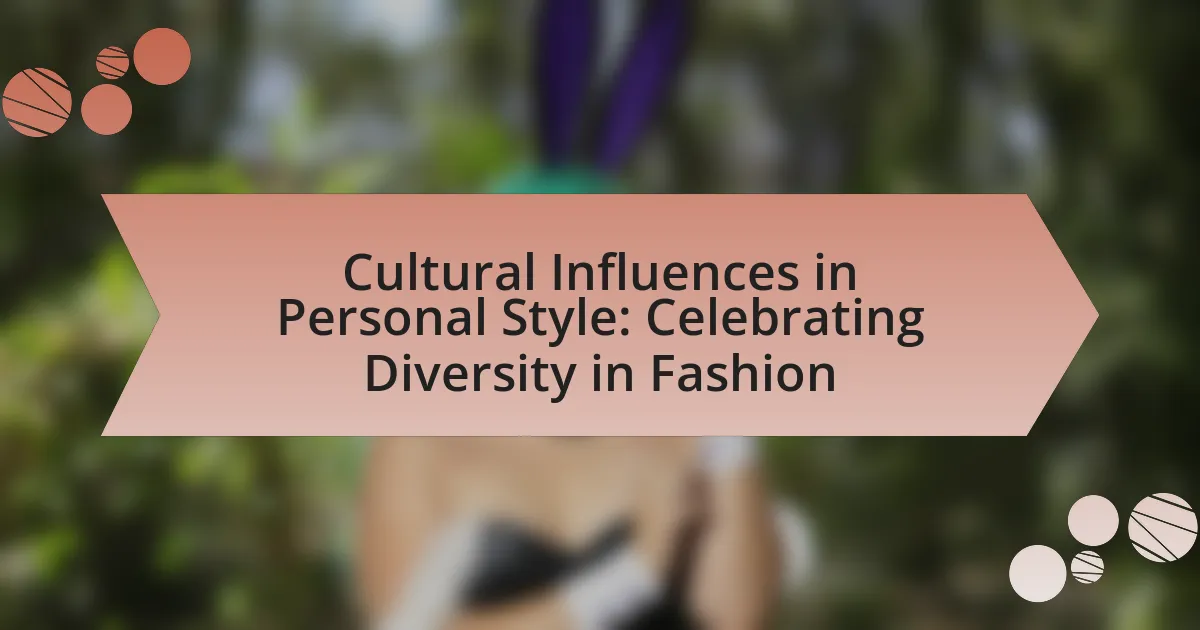Cultural influences in personal style encompass the ways an individual’s fashion choices are shaped by their cultural background, traditions, and societal norms. This article explores how different cultures impact individual fashion preferences, highlighting elements such as traditional garments, social customs, and historical contexts. It emphasizes the importance of celebrating diversity in fashion, addressing challenges like cultural appropriation and misrepresentation, while advocating for inclusivity through representation and collaboration. Additionally, the article discusses practical steps for individuals and brands to honor cultural traditions and promote diversity within the fashion industry.

What are Cultural Influences in Personal Style?
Cultural influences in personal style refer to the ways in which an individual’s clothing choices, accessories, and overall aesthetic are shaped by their cultural background, traditions, and societal norms. These influences can manifest through specific garments, patterns, colors, and styles that are emblematic of particular cultures, such as the use of kimonos in Japanese fashion or the incorporation of African prints in contemporary attire. Historical context plays a significant role, as fashion often reflects the values, beliefs, and social structures of a culture, with examples like the adoption of Western styles in various global contexts illustrating the impact of globalization on personal style.
How do different cultures shape individual fashion choices?
Different cultures significantly shape individual fashion choices through their unique traditions, values, and aesthetics. For instance, traditional garments like the kimono in Japan or the sari in India reflect cultural heritage and social identity, influencing how individuals express themselves through clothing. Additionally, cultural events and festivals often dictate specific attire, reinforcing communal ties and shared values. Research indicates that exposure to diverse cultural influences can lead to a broader acceptance of various fashion styles, as seen in urban areas where multicultural populations blend different fashion elements. This interplay between culture and fashion not only enhances personal expression but also fosters a greater appreciation for diversity in style.
What elements of culture influence personal style?
Elements of culture that influence personal style include traditions, values, social norms, and historical context. Traditions shape clothing choices, such as the use of specific garments for cultural ceremonies, while values dictate preferences for sustainability or luxury. Social norms influence what is considered fashionable within a community, and historical context can affect style through the revival of past trends. For example, the influence of African textiles in contemporary fashion highlights how cultural heritage can inspire modern design, demonstrating the interplay between culture and personal expression.
How do traditions and customs affect fashion preferences?
Traditions and customs significantly shape fashion preferences by dictating the styles, colors, and materials deemed appropriate within a culture. For instance, in many Asian cultures, traditional garments like the kimono in Japan or the saree in India are not only worn during festivals and ceremonies but also influence contemporary fashion trends, leading to a blend of traditional and modern aesthetics. Additionally, cultural customs surrounding modesty can dictate clothing choices, as seen in various Middle Eastern countries where loose-fitting garments are preferred. This influence is supported by studies showing that cultural identity plays a crucial role in individual fashion choices, as individuals often seek to express their heritage through their attire.
Why is celebrating diversity in fashion important?
Celebrating diversity in fashion is important because it fosters inclusivity and representation, allowing individuals from various backgrounds to express their identities. This inclusivity not only enriches the fashion industry by introducing a wider range of styles and perspectives but also reflects the multicultural society we live in. According to a 2020 report by McKinsey & Company, brands that prioritize diversity in their marketing and product offerings see a significant increase in customer loyalty and market share, demonstrating that embracing diversity is not only socially responsible but also economically beneficial.
What role does representation play in fashion diversity?
Representation plays a crucial role in fashion diversity by ensuring that various cultural, ethnic, and body types are visible and celebrated within the industry. This visibility fosters inclusivity, allowing consumers from diverse backgrounds to see themselves reflected in fashion, which can enhance their sense of belonging and self-identity. Studies indicate that brands that embrace diverse representation not only attract a broader customer base but also experience increased loyalty and sales; for instance, a 2020 report by McKinsey & Company found that companies with diverse leadership teams are 33% more likely to outperform their peers in profitability. Thus, representation in fashion is essential for promoting diversity, driving consumer engagement, and ultimately contributing to the industry’s growth.
How does diversity in fashion promote inclusivity?
Diversity in fashion promotes inclusivity by representing a wide range of identities, cultures, and body types, which allows individuals to see themselves reflected in the industry. This representation fosters a sense of belonging and acceptance among diverse consumer groups. For instance, brands that feature models of various ethnicities, sizes, and gender identities not only challenge traditional beauty standards but also encourage consumers to embrace their uniqueness. Research from the Fashion Institute of Technology indicates that inclusive marketing strategies can increase brand loyalty by 30%, demonstrating that consumers respond positively to diversity in representation.
What are the historical contexts of cultural influences in fashion?
The historical contexts of cultural influences in fashion are shaped by significant events, movements, and exchanges throughout history. For instance, the Renaissance period in Europe saw a revival of classical art and culture, which influenced fashion through the adoption of luxurious fabrics and intricate designs. The Industrial Revolution introduced mass production, making fashion more accessible and leading to the rise of ready-to-wear clothing. Additionally, the globalization of trade routes facilitated the exchange of textiles and styles, such as the influence of Asian silk and patterns on European fashion in the 17th century. The 20th century brought about cultural movements like the Harlem Renaissance, which celebrated African American culture and significantly impacted fashion through bold colors and styles. Each of these historical contexts illustrates how cultural interactions and societal changes have continuously shaped fashion trends and personal style.
How have historical events shaped fashion trends across cultures?
Historical events have significantly shaped fashion trends across cultures by influencing styles, materials, and societal norms. For instance, the Industrial Revolution in the 18th and 19th centuries introduced mass production, making clothing more accessible and leading to the rise of ready-to-wear fashion. Additionally, World War II prompted women to enter the workforce, resulting in practical clothing styles that emphasized functionality, such as trousers and utilitarian designs. The 1960s counterculture movement further transformed fashion by promoting individual expression and rejecting traditional norms, leading to the adoption of bold colors and eclectic styles. These examples illustrate how historical contexts directly impact fashion evolution, reflecting societal changes and cultural exchanges.
What are some key milestones in the evolution of cultural fashion?
Key milestones in the evolution of cultural fashion include the emergence of the Silk Road in the 2nd century BCE, which facilitated the exchange of textiles and styles between East and West. The Renaissance period in the 14th to 17th centuries marked a significant shift as European fashion began to incorporate influences from the Middle East and Asia, leading to the use of luxurious fabrics and intricate designs. The Industrial Revolution in the 18th and 19th centuries introduced mass production, making fashion more accessible and diverse. The 20th century saw the rise of cultural movements, such as the Harlem Renaissance, which celebrated African American culture and influenced mainstream fashion. Additionally, the globalization of fashion in the late 20th and early 21st centuries has led to a blending of styles from various cultures, promoting inclusivity and diversity in personal style.

How do Cultural Influences Manifest in Personal Style?
Cultural influences manifest in personal style through the incorporation of traditional garments, patterns, and colors that reflect a person’s heritage. For example, individuals may wear clothing that features specific motifs or textiles unique to their culture, such as African kente cloth or Japanese kimono fabrics, which serve as expressions of identity and . Additionally, cultural practices and historical contexts shape fashion choices, as seen in the adoption of styles that resonate with cultural celebrations or rituals, like the use of vibrant colors during festivals. This connection between culture and personal style is supported by studies indicating that clothing choices often reflect cultural identity and social belonging, highlighting the significance of cultural heritage in shaping individual fashion expressions.
What are the various types of cultural fashion influences?
Cultural fashion influences can be categorized into several types, including traditional, contemporary, global, and subcultural influences. Traditional influences stem from historical attire and customs of specific cultures, such as kimono in Japan or sari in India, which reflect cultural heritage and identity. Contemporary influences arise from modern fashion trends that often blend various cultural elements, exemplified by streetwear that incorporates global styles. Global influences are shaped by the interconnectedness of cultures through globalization, leading to the fusion of fashion styles across different regions, such as Western brands adopting Eastern motifs. Subcultural influences emerge from distinct groups, such as punk or hip-hop, which create unique fashion statements that challenge mainstream norms. Each type of influence contributes to the rich tapestry of global fashion, showcasing the diversity and evolution of personal style.
How do regional styles differ within the same culture?
Regional styles within the same culture differ primarily due to variations in geography, climate, history, and local traditions. For instance, in the United States, Southern fashion often incorporates lighter fabrics and bright colors to accommodate warmer climates, while Northern styles may favor heavier materials and darker tones due to colder weather. Historical influences also play a role; for example, the influence of Native American patterns in Southwestern attire contrasts with the more European-inspired styles found in the Northeast. These differences are further accentuated by local customs and practices, such as festivals or community events, which can dictate specific styles or garments unique to a region.
What are some examples of cultural fashion fusion?
Cultural fashion fusion examples include the blending of traditional African prints with Western silhouettes, as seen in brands like Duro Olowu, which celebrates Nigerian heritage through contemporary designs. Another example is the incorporation of Japanese kimono elements into Western streetwear, popularized by designers such as Issey Miyake. Additionally, the use of Indian textiles and embroidery in modern Western fashion, exemplified by designers like Naeem Khan, showcases the integration of South Asian aesthetics into global fashion. These instances illustrate how diverse cultural elements can create innovative and hybrid fashion styles.
How do social media and globalization impact cultural fashion?
Social media and globalization significantly influence cultural fashion by facilitating the rapid exchange of styles and trends across diverse regions. This interconnectedness allows for the blending of traditional and contemporary fashion elements, leading to hybrid styles that reflect multiple cultural influences. For instance, platforms like Instagram and TikTok enable users to showcase their unique fashion choices, which can quickly gain popularity worldwide, as seen with the rise of streetwear and the incorporation of ethnic patterns into mainstream fashion. According to a 2021 report by McKinsey & Company, 75% of consumers are influenced by social media when making fashion purchases, highlighting the platform’s role in shaping cultural fashion trends.
What role does social media play in promoting cultural styles?
Social media plays a crucial role in promoting cultural styles by providing a platform for diverse expressions and visibility of various cultural aesthetics. Through platforms like Instagram, TikTok, and Pinterest, users can share images, videos, and stories that highlight traditional and contemporary fashion from different cultures, thus fostering appreciation and understanding. For instance, a study by the Pew Research Center found that 69% of adults in the U.S. use social media, which amplifies the reach of cultural styles and influences trends globally. This widespread engagement allows for the rapid dissemination of cultural fashion, enabling users to adopt and adapt styles from around the world, thereby celebrating diversity in personal style.
How has globalization affected traditional fashion practices?
Globalization has significantly impacted traditional fashion practices by facilitating the exchange of cultural styles and materials across borders. This exchange has led to the blending of traditional garments with contemporary designs, resulting in hybrid fashion that reflects both local heritage and global trends. For instance, the incorporation of Western styles into traditional attire can be seen in various cultures, such as the adoption of denim in Indian fashion, where traditional sarees are paired with modern fabrics. Additionally, globalization has increased access to diverse textiles and production techniques, allowing artisans to innovate while preserving their cultural identity. According to a study by the Fashion Institute of Technology, 70% of designers reported that global influences have reshaped their collections, highlighting the profound effect of globalization on traditional fashion practices.
What challenges do cultural influences face in the fashion industry?
Cultural influences in the fashion industry face challenges such as appropriation, misrepresentation, and market accessibility. Appropriation occurs when elements of a culture are used without understanding or respect, often leading to backlash from the originating community. Misrepresentation arises when cultural symbols are inaccurately portrayed, which can perpetuate stereotypes and harm the cultural identity. Additionally, market accessibility is a challenge, as designers from diverse backgrounds may struggle to gain visibility and support in a predominantly Western-centric industry, limiting their ability to share their cultural narratives. These challenges highlight the need for greater sensitivity and inclusivity in fashion practices.
How can cultural appropriation be addressed in fashion?
Cultural appropriation in fashion can be addressed by promoting ethical practices that respect and honor the origins of cultural elements. Fashion brands should engage in meaningful collaborations with cultural communities, ensuring that creators are compensated and credited for their contributions. For instance, the 2019 collaboration between the brand Kith and the Native American community exemplifies how respectful partnerships can celebrate cultural heritage while avoiding appropriation. Additionally, educating designers and consumers about the significance of cultural symbols can foster greater awareness and sensitivity, reducing instances of appropriation. Implementing guidelines and policies that prioritize cultural respect within the fashion industry can further mitigate appropriation issues.
What are the implications of fast fashion on cultural styles?
Fast fashion significantly homogenizes cultural styles by prioritizing mass production and rapid consumption over traditional craftsmanship and unique cultural expressions. This phenomenon leads to the dilution of distinct cultural identities, as global brands often replicate and commercialize traditional garments without proper context or respect for their origins. For instance, the widespread availability of culturally inspired clothing can overshadow local artisans and diminish the economic viability of traditional textile practices. Additionally, fast fashion’s emphasis on trends encourages consumers to favor fleeting styles over meaningful cultural attire, resulting in a loss of appreciation for the heritage and significance behind these garments.

What Practical Steps Can Be Taken to Celebrate Diversity in Fashion?
To celebrate diversity in fashion, brands and designers can implement inclusive sizing, collaborate with diverse models, and showcase a variety of cultural influences in their collections. Inclusive sizing ensures that clothing is available for all body types, reflecting the reality that beauty comes in many forms. Collaborating with diverse models allows for representation across different ethnicities, genders, and ages, which can resonate with a broader audience. Additionally, showcasing cultural influences in collections can highlight the richness of global fashion traditions, promoting appreciation and understanding of different cultures. For instance, brands like Savage X Fenty have been recognized for their commitment to inclusivity, featuring models of various backgrounds and body types, which has positively impacted their market reach and brand loyalty.
How can individuals incorporate cultural influences into their personal style?
Individuals can incorporate cultural influences into their personal style by integrating traditional garments, patterns, and accessories from various cultures into their wardrobe. For example, wearing a kimono jacket with modern outfits or accessorizing with African beaded jewelry can create a unique blend of styles. This approach not only showcases appreciation for different cultures but also promotes diversity in fashion. Studies indicate that multicultural fashion influences can enhance creativity and self-expression, allowing individuals to reflect their identity through diverse cultural elements.
What are some tips for blending cultural elements in fashion?
To blend cultural elements in fashion effectively, one should research and understand the origins and significance of the cultural elements being incorporated. This foundational knowledge ensures respectful representation and avoids cultural appropriation. For instance, using traditional patterns or textiles from a specific culture can be done thoughtfully by acknowledging their history and meaning, as seen in the use of African prints by various designers who highlight their cultural significance. Additionally, mixing elements from different cultures can create a harmonious look by focusing on complementary colors and styles, as demonstrated in the work of designers like Stella Jean, who combines Italian tailoring with Caribbean influences. Engaging with cultural communities and seeking their input can further enhance authenticity and appreciation in fashion design.
How can one respectfully honor cultural traditions in personal style?
One can respectfully honor cultural traditions in personal style by incorporating authentic elements from those cultures while ensuring proper understanding and appreciation of their significance. This involves researching the cultural background, meanings, and contexts of specific garments or accessories, which helps avoid cultural appropriation. For instance, wearing traditional attire, such as a kimono or sari, should be done with awareness of the cultural practices surrounding them, including occasions for wear and appropriate styling. Engaging with cultural communities and supporting artisans who create traditional garments also fosters respect and appreciation, as it acknowledges the cultural heritage and craftsmanship involved.
What initiatives promote diversity in the fashion industry?
Initiatives that promote diversity in the fashion industry include programs like the Diversity Coalition, which aims to increase representation of marginalized groups in fashion through mentorship and funding. Additionally, organizations such as the Council of Fashion Designers of America (CFDA) have launched initiatives like the “A Common Thread” campaign, which supports designers from diverse backgrounds. Research indicates that diverse representation can lead to increased market reach and consumer engagement, as seen in studies showing that brands with inclusive marketing strategies experience higher sales growth.
How can brands support cultural representation in their collections?
Brands can support cultural representation in their collections by actively collaborating with diverse designers and communities to create authentic and inclusive designs. This approach not only ensures that various cultural narratives are accurately represented but also fosters a sense of belonging among consumers from those cultures. For instance, brands like Gucci and Dior have partnered with artists and artisans from different cultural backgrounds, showcasing traditional craftsmanship and storytelling in their collections. Such collaborations can lead to increased visibility and appreciation of cultural heritage, as evidenced by the rise in popularity of collections that celebrate indigenous and local craftsmanship, which have seen a significant consumer response and engagement.
What role do fashion shows and events play in celebrating diversity?
Fashion shows and events play a crucial role in celebrating diversity by showcasing a wide range of cultural expressions and body types. These platforms highlight designers from various backgrounds, allowing them to present their unique perspectives and styles, which fosters inclusivity within the fashion industry. For instance, events like New York Fashion Week have increasingly featured models of different ethnicities, sizes, and ages, reflecting the diverse consumer base and challenging traditional beauty standards. This shift not only promotes representation but also encourages dialogue around cultural appreciation and acceptance, as seen in initiatives like the Diversity Coalition, which aims to increase representation in fashion.
What are some best practices for embracing cultural diversity in fashion?
To embrace cultural diversity in fashion, brands should prioritize inclusivity by collaborating with designers from diverse backgrounds. This practice not only enriches the creative process but also ensures authentic representation of various cultures. For instance, brands like Gucci and Dior have successfully integrated cultural elements by partnering with designers from different ethnicities, showcasing traditional craftsmanship and styles in their collections. Additionally, conducting thorough research on cultural significance and avoiding cultural appropriation is essential; this can be supported by guidelines from organizations like the Council of Fashion Designers of America, which emphasize respect and understanding of cultural heritage. By implementing these best practices, the fashion industry can foster a more inclusive environment that celebrates diversity.
